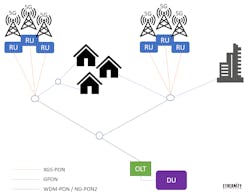There has been a lot of publicity recently for China’s leading role in 5G deployment, primarily focused on the installation of over 600,000 5G towers and base stations throughout the country. While this is significantly more than any other country has built, it is a mere fraction of the total number of towers that will be required for China to offer true nationwide 5G coverage.
To drive and sustain the required high bandwidth in 5G, the wireless radio channels had to be adjusted toward using a millimeter-wave band. Although this has the ability to support higher capacities, it comes with one major drawback: distance. Millimeter waves can drive large throughputs, but the signal radius is reduced from 1 km in 4G radio to only 100 m (or even less, depending on the terrain). This necessarily means that 5G requires more access points for the same coverage as 4G. In fact, estimates range from between 20-50 times more antennas are required, which means it could take as many as 10 million towers before China can achieve complete 5G penetration.
Similarly, as North American and European operators are rolling out their 5G offerings, they are touting nationwide coverage. The truth is that there is no such thing as a nationwide network for 5G yet. Operators have begun their rollouts by testing the network with towers that can reach pockets within certain cities and in rural areas that struggled to receive 4G signals. Until there are enough towers in place to provide coverage wherever and whenever, there will be limited 5G service in every country in the world.
This mass deployment of a dense network of base stations will lead to a major infrastructural challenge that is rarely discussed when 5G networks are planned: How are all these towers going to be connected?
Whereas in legacy 4G network architecture, a base station was co-located with each tower, requiring a large physical space complete with backup battery and temperature control, 5G networks have separated the data processing within the distributed unit (DU) from the signal-bearing radio unit (RU). Moving DUs to telco central offices at the edge of the access network reduces both the size and cost of base stations, which is critical given the significantly greater number of towers (Figure 1).
Plus, the physical separation of the DU from the RU requires a much greater reliance on fiber to bridge between them. Moreover, that fiber must now accommodate much larger capacity to meet 5G bandwidth requirements, which can extend to as much 20 times the required capacity of 4G LTE. And these fiber connections must enable extremely low latency of up to 10 times less delay than LTE.
The first option would be to lay all new fiber to connect these millions of radio towers. But this would result in a huge delay, fraught with logistical constraints and a major added cost for operators.
The benefits of 5G cannot be fully realized until operators can find a way to address these tremendous infrastructure expenses. It is therefore important for operators to optimize the cost of deploying their towers and the last-mile transport to reach the base stations. To do so, it makes sense to maximize capacity within the RAN by exploiting existing fiber infrastructure.
Therefore, the logical solution is to use passive optical networks (PONs) where they are already available for fiber-to-the-home connectivity. PONs can enable the 5G data to be transported via fiber s from the radio towers to the RAN.
The opportunity for PON
PON is flexible, reliable, and efficient enough to provide fronthaul transport for both cellular and fixed broadband in a single network, which is a huge advantage over other distribution networks that require different types of distribution for different technologies.
In many countries, there is an existing PON network that is deployed to enable broadband fiber-to-the-home/business (FTTx). For 5G to reach home and enterprise locations, there also must be a connection from the millions of radio antennas to the RAN. By using an architecture based on the point-to-multipoint tree topology of PON, operators can reduce the amount of trunk fibers that are used.
Existing FTTx networks are large and extensive, with sufficient line and port resources as well as the necessary optical devices and power supply. PON offers resilience, such that connectivity is maintained even if a line is disconnected. Most of all, PON reduces networking costs by reusing existing fiber and optical filters, and it can handle various traffic streams with much greater capacity than other transport options.
As such, existing PON fiber is an ideal conduit and cost-effective solution for transporting 5G traffic from the RUs to the DUs and perhaps even onward to the rest of the access network.
PON options
There are different flavors of PON that are being discussed as possible options for 5G infrastructure. FTTH has a maximum requirement at present of GPON, which can provide a top capacity of about 2.5-Gbps downstream and 1.2-Gbps upstream. But fronthaul requires significantly more capacity, such as XGS-PON, which can offer 10-Gbps upstream and downstream, on the road toward 25G PON.
Many operators are now seeking support for WDM-PON (sometimes called Combined PON – CPON), which overlays new wavelengths onto legacy PON networks without compromising the bandwidth of the existing fixed broadband service. For example, a single fiber could make use of four colors (wavelengths) within the fiber for GPON (two upstream and two downstream) to serve both GPON for FTTH and XGS-PON for 5G fronthaul on the same fiber. Thus, the same existing infrastructure and same optics can be used both to reach the home and to connect from the RU to the DU (Figure 2).
There is one primary limitation implicit in the use of PON for 5G. Because PON is a TDMA protocol, there is naturally added delay between the arrival of the traffic and the response to permit delivery. This can pose as much as a millisecond delay, which is very significant in 5G terms. That said, WDM-PON has shown promise as a low-latency fronthaul transport option.
Otherwise, there has not been a lot of progress related to overcoming latency issues in fronthaul to date, although there have been various solutions proposed to address this limitation. One such proposal makes use of the DU and CU to notify an OLT whenever a user in its region is accessing the 5G network, so that bandwidth can be allocated in advance without the need to wait for permission.
PON and 5G match well
Certainly as more 5G networks are advanced toward mass deployment, and as PONs are recognized as cost-efficient, high-capacity means of deploying 5G transport from antenna to RAN, more effort will be dedicated toward working around and reducing the latency to meet the 5G benchmarks.
Ultimately, PON differentiates itself to service providers as the optimal 5G fronthaul transport option because it is readily available and it offers a single distribution network for both fixed broadband and cellular data transport. But PON also provides value because it is simple to install, it scales and can be configured easily based on demand, it is interoperable with other deployed networking architectures, and it is extremely reliable. Most of all, PON optimizes operator costs, which is critical at a time when so much infrastructure expense is being allocated toward implementing the necessarily dense network of towers that are the backbone of 5G.
David Levi is the CEO and founder of Ethernity Networks. Prior to Ethernity, David was granted two U.S. patents regarding GPON protocol-related inventions. He founded Broadlight, which created BPON and GPON components and was acquired by Broadcom.


